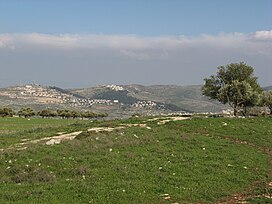Mount Ebal
| Ebal | |
|---|---|
 View of Mount Ebal | |
| Highest point | |
| Elevation | 935 m (3,068 ft) |
| Coordinates | 32°14′02″N 35°16′24″E / 32.234°N 35.2733°E |
| Geography | |
 | |
Mount Ebal (

Biblical account
In advance of the Israelites' entry to the Promised Land, Deuteronomy 11:29 records Moses' direction that "when the Lord your God has brought you into the land which you go to possess, that you shall put the blessing on Mount Gerizim and the curse on Mount Ebal".
In the
An instruction immediately subsequent to this orders that, once this is done, the Israelites should split into two groups, one to stay on Mount Ebal and pronounce curses, while the other goes to Mount Gerizim and pronounces blessings.[11] The tribes of Simeon, Levi, Judah, Issachar, Joseph and Benjamin were to be sent to Gerizim, while those of Reuben, Gad, Asher, Zebulun, Dan and Naphtali, were to remain on Ebal.[11] No attempts to explain this division of tribes either by their Biblical ethnology or by their geographical distribution have been generally accepted in academic circles.[7]
The text goes on to list twelve curses, which were to be pronounced by the
In the
Much later in the Book, when Joshua was old and dying, he gathered the people together at Shechem, and gave a farewell speech, and then wrote these words in the book of the Torah of God, and took a great stone, and set it under the doorpost which is in the sanctuary of the Lord.[18] Depending on the way in which the sources of Joshua were spliced together, this may just be another version of the earlier narrative of Joshua placing the whitened stones slabs with the Torah inscribed on them, and some scholars believe that this narrative may have originally been in an earlier location within the Book of Joshua.[7]
In the Biblical narrative, the

Archaeology
Mount Ebal site (Northern el-Burnat)
In 1980, a structure on Mount Ebal was discovered by Israeli archaeologist
In February 2021 a portion of the site was destroyed by the Palestinian Authority and the stones were ground up and used to pave a nearby road.[25]

Western sites
The higher part of the mountain, on the west, contains the ruins of some massive walls called Al-Kal'ah, and east of this are other ruins now called Kunaisah.[20]
References
- ^ Photograph of the southern face of the mountain
- ^ ISBN 0-7472-4510-X
- ^ Encyclopedia Biblica
- ^ Jewish Encyclopedia
- ^ Deuteronomy 27:4–6
- ^ Deuteronomy 27:4–8,29
- ^ a b c d e f Peake's Commentary on the Bible
- ISBN 978-90-04-29603-9.
- ^ Charlesworth, James H. "The Discovery of an Unknown Dead Sea Scroll: The Original Text of Deuteronomy 27?" Archived 2015-11-26 at the Wayback Machine OWU Magazine; 2012/07/16
- ISBN 978-3-11-058141-6.
- ^ a b Deuteronomy 27:11-13
- ^ Deuteronomy 15–26
- ^ Deuteronomy 28:3–6
- ^ Deuteronomy 28:16–19
- ^ Joshua 8:31-35
- ^ Jewish Encyclopedia
- ^ Richard Elliott Friedman, Who wrote the Bible; Jewish Encyclopedia, Book of Joshua, Deuteronomy
- ^ Joshua 24:1-27
- ^ Genesis 35:4
- ^ a b Jewish Encyclopedia
- ^ ISBN 978-1-57506-243-3.
- ISBN 978-1-58983-097-4.
... the consensus today tends to support the cultic interpretation of this early Iron I site, if not the biblical one (see Mazar 1990a, 348–50; Coogan 1987; 1990; Zevit 2001, 196–201).
- ISBN 978-90-04-29603-9. Retrieved 14 July 2023.
- ISBN 978-952-12-3046-2. Retrieved 14 July 2023.
- JPost. Retrieved 11 February 2021.



